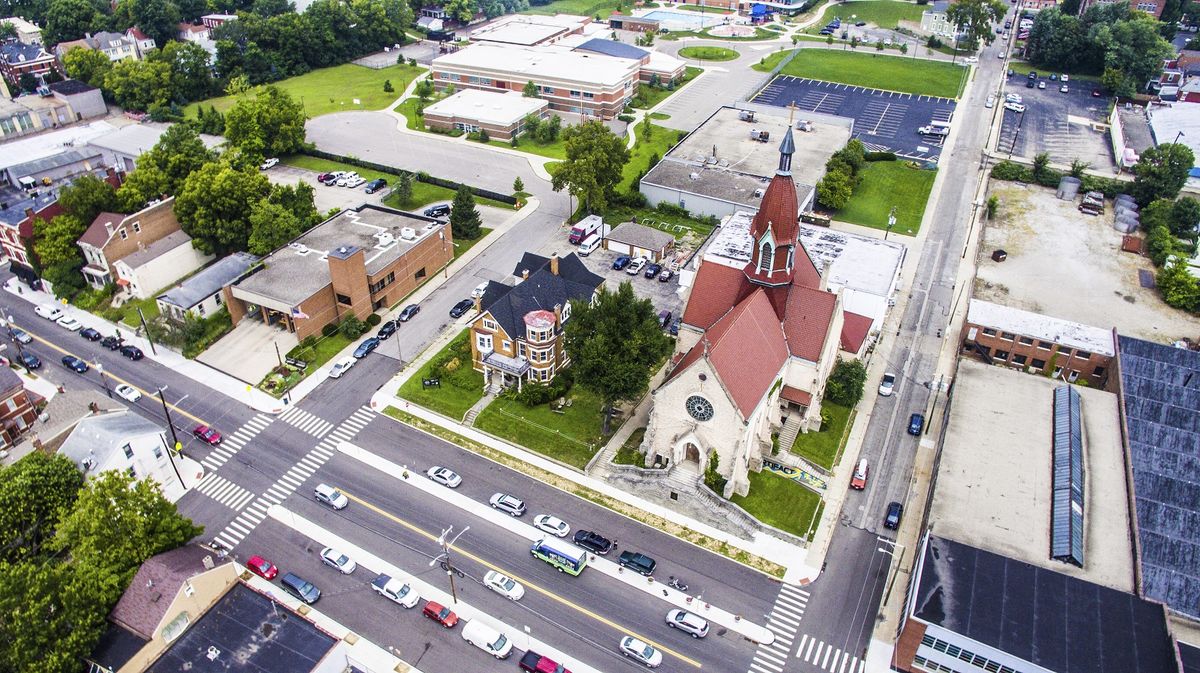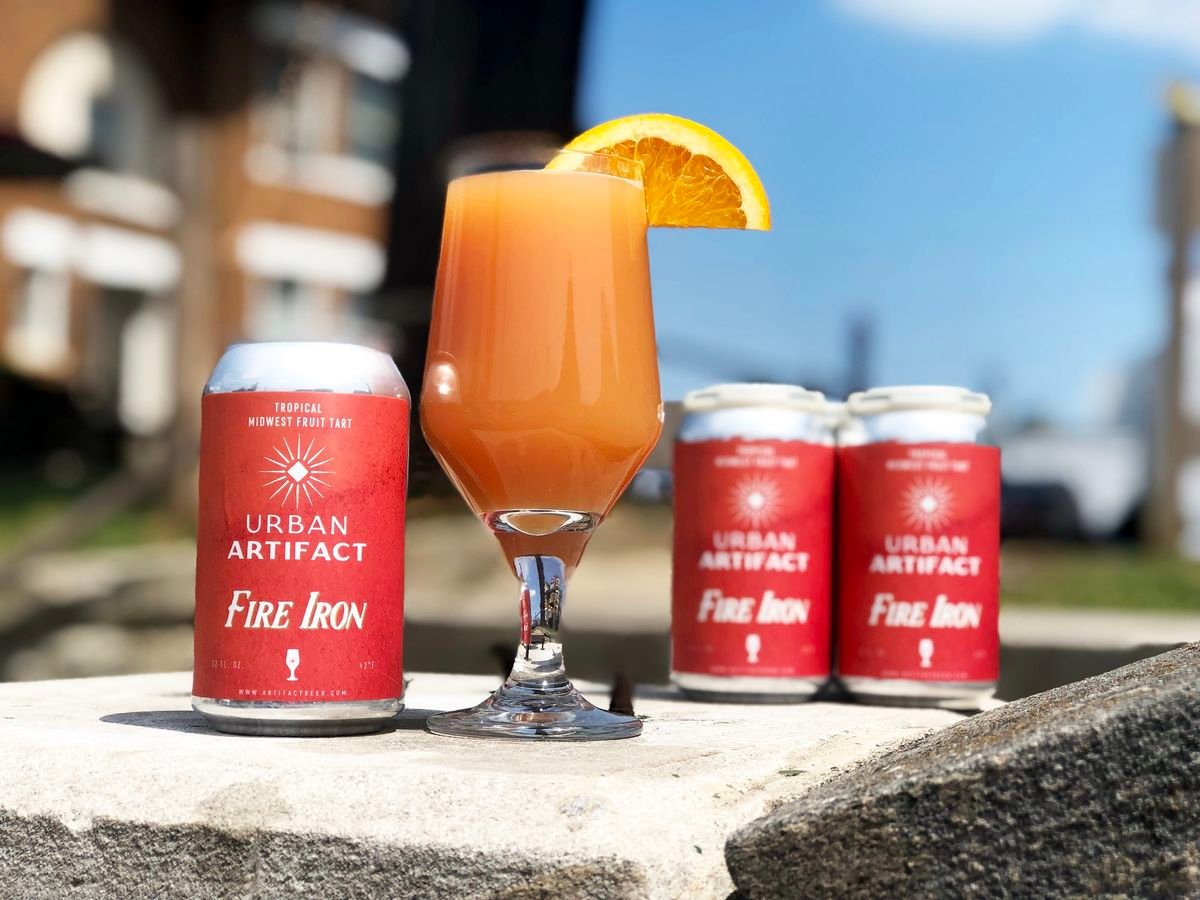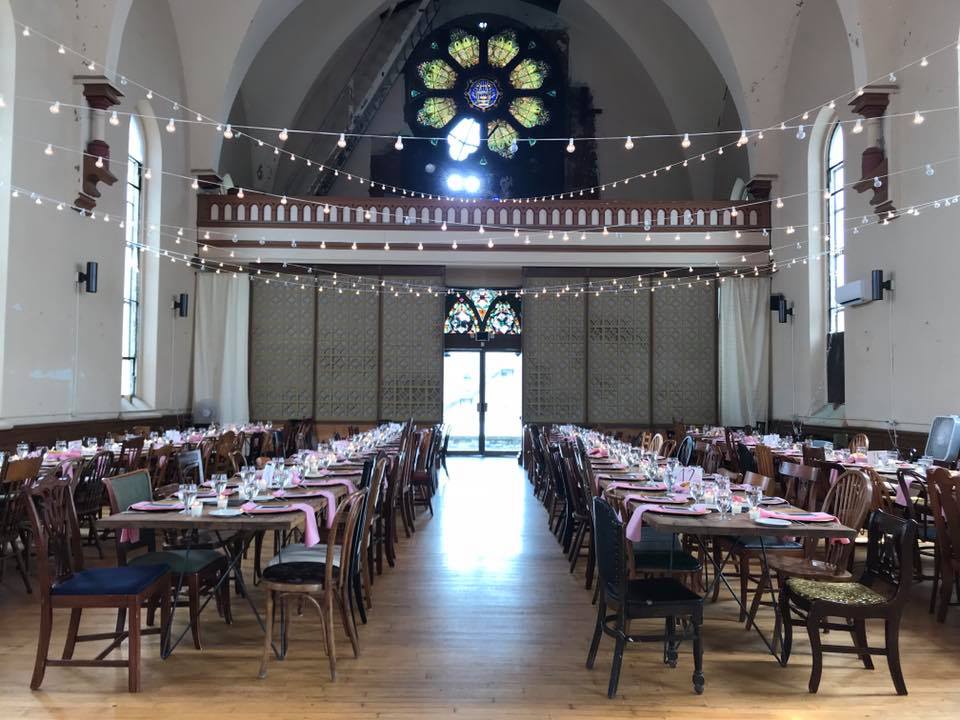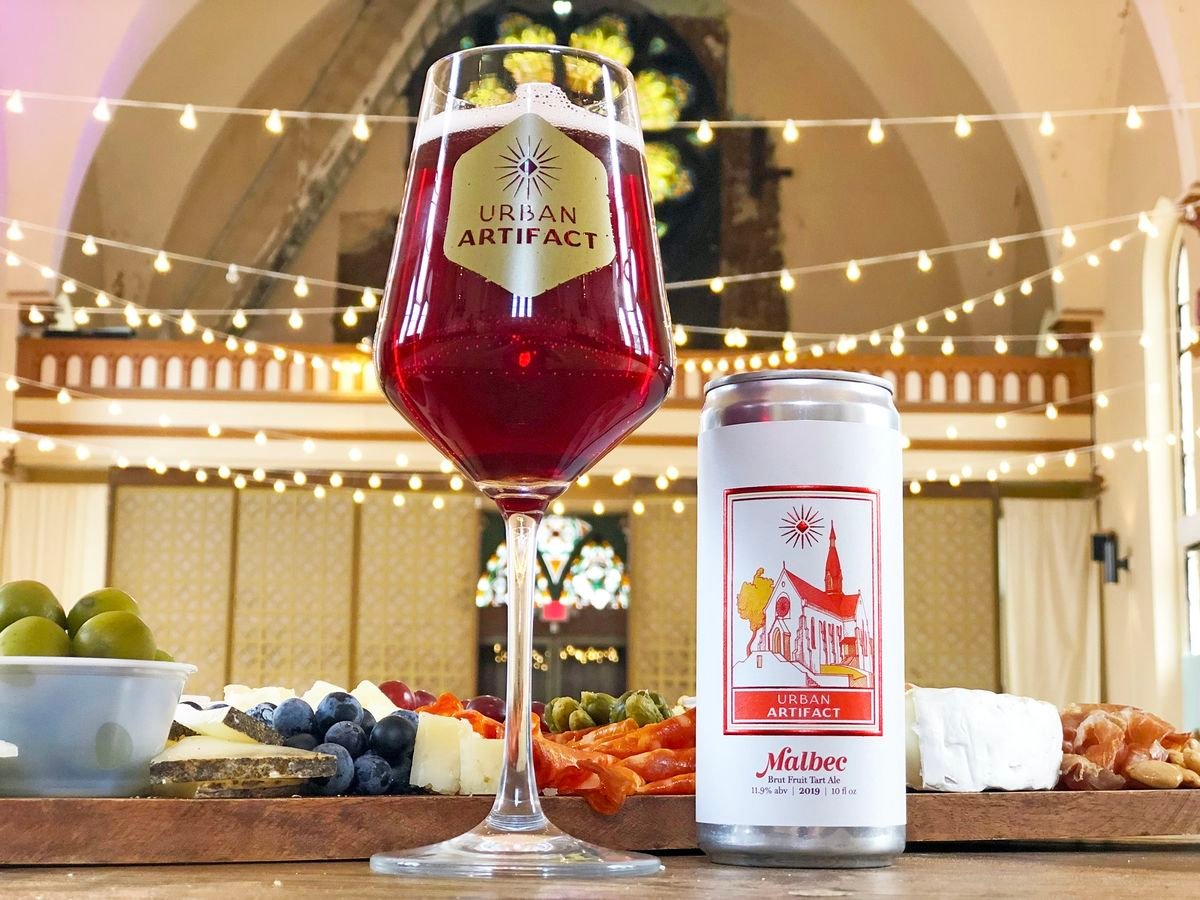Start 14-Day Trial Subscription
*No credit card required

Urban Artifact Brewery Tour
Urban Artifact’s home in the Northside neighborhood of Cincinnati, Ohio, was a house of worship for the first 140 years of its existence. Some would argue it still is, with the brewery’s fruited sour ales earning praise and devotion from the region’s beer faithful.
Taking up an entire block on an industrial side street, the church property that houses Urban Artifact was built in 1873 as St. Aloysius Catholic Church, though for most of the next century it was home to St. Patrick Irish Catholic. After a short period as a cookie factory, it was purchased by the founders of Urban Artifact in 2014.
“I can’t believe how much the space has changed since then,” says co-founder and chief of strategic development Scotty Hunter as we stand in the taproom in the church basement. “We did all this on a boot-strap budget.”
The brewery has used every bit of the former church property to make a home in the Cincinnati metro area of just over two million people. The intimate taproom in the church basement has seating for 75. The gorgeous upstairs sanctuary, with its wood floors, stained glass windows, and vaulted ceiling, is used for special events. The rectory building next door holds office space for non-profits, as well as the brewery’s very own FM music station, Radio Artifact. The church gym, built in the 1960s, holds the production and packaging operation.
“Our name was partially inspired by this property,” says Hunter. “The church is an artifact itself in the urban core of Cincinnati.”
Formerly a blue-collar industrial neighborhood, Northside now balances the remnants of that working class life with a thriving arts scene.
“Northside to me is a hidden gem in Cincinnati,” says Hunter. “It’s walkable and eclectic.”

Formerly a blue-collar industrial neighborhood, Northside now balances the remnants of that working class life with a thriving arts scene.“Northside to me is a hidden gem in Cincinnati,” says Co-Founder Scotty Hunter. “It’s walkable and eclectic.”
Eclectic also describes Urban Artifact’s liquid offerings. There are no conventional IPAs, stouts, or lagers in sight here. The brewery has carved out a niche in the competitive Cincinnati beer scene by brewing a range of sour, fruited and funky beers.
Urban Artifact’s Midwest Fruit Tart series is among their most popular, featuring gently sour ales around 8% ABV brewed with fruits ranging from berries to apricots to guava. The brewery periodically partners with a local chef or food professional to create beers in their Epicurean series, which riff on popular food flavors.
A diverse array of barrel-aged and funky beers is released throughout the year in corked and caged bottles. These mixed-fermentation ales were once a bigger part of Urban Artifact’s identity, but the public clamored for more of the fruited sour ales, and Urban Artifact allowed their focus to evolve to meet the demand.
“We found what our customers respond to, and that’s shelf-stable fruited sours,” explains Hunter as we walk into the production room of the brewery where a new beer in the Midwest Fruit Tart series is being canned. Pie Bird is made with boysenberries, and the entire brewery smells like a berry muffin.
As workers busily can the deep magenta-hued Pie Bird, co-founder and brewer Bret Kollmann-Baker steps aside to talk about the brewery’s unorthodox methods for collecting yeast and bacteria.
It’s no secret to brewers that yeast and bacteria are everywhere. They’re in the air, on most surfaces and on us. The challenge brewers generally face is in keeping unwanted microbes out of their beer. The folks at Urban Artifact harness that reality to capture cultures from their property and surrounding environment to anchor their beers to their place of origin.
“We set out fifty jars of wort all over the property to collect cultures,” says Kollmann-Baker. “The one we went with was collected in the bell tower, and it just produced this really clean acidity and notes of stone fruit.”
The brewery has since had the culture banked with Omega Yeast Labs in Chicago.
Kollmann-Baker has occasionally gone farther afield to collect unique brewing cultures as well. One notable example came earlier this year when local beer historian and documentarian Mike Morgan told the Urban Artifact crew about a 150-year-old wood fermentation vat that had been discovered intact in one of the city’s abandoned lagering tunnels. Many German immigrants started breweries in Cincinnati in the mid-1800s, and a lot of lagering tunnels were built beneath the city, just like this one formerly owned by the F & J.A. Linck Brewery.
Kollmann-Baker was intrigued about the possibility of capturing yeast from the long-forgotten vessel, and samples were taken and sent off to Omega’s labs for analysis. One yielded viable Saccharomyces cerevisiae ale yeast, which the brewery then used in a beer called Missing Linck.
The brewers have also collected cultures at nearby St. Anthony’s Friary and brewed a resulting sour quadrupel ale in collaboration with the homebrewing brothers there.

Urban Artifact has carved out a niche in the competitive Cincinnati beer scene by brewing a range of sour, fruited and funky beers such as Fire Iron, a "Midwest Fruit Tart" beer.
When I ask Kollmann-Baker if he believes these locally captured cultures give his beers terroir, he smiles.
“Yes, I’m a firm believer that what we do is a true expression of where we are.”
Hunter takes me across the street to a warehouse the brewery leases from a neighboring company. The aging industrial structure might not resemble the former house of worship the brewery calls home, but what rests inside inspires no less reverence. As we enter a dim back room in the corner of the building, Urban Artifact’s 160 oak barrels come into view, containing a variety of rare and mixed-fermentation beers the brewery will release only when they’re ready. The response to these wild and mixed-fermentation beers has been small but passionate, and they’re labors of love for the Urban Artifact team.
“We follow a Belgian traditional approach to brewing these beers,” explains Hunter. “We produce wort and ferment it in the cooler months, and then generally package it in the warmer months.”
As we leave the warehouse, I ask Hunter what his favorite Urban Artifact beer is. Most brewery owners defer, unwilling to say which of their children they love the most. Hunter doesn’t hesitate long, however.
“Finn,” he declares, referring to a year-round “Tart Pale Ale” that’s a cross between a Berliner Weisse and a low-bitterness American Pale Ale. “It’s light, crisp and balanced, and it’s fruity from the hops and the lacto.”
It’s one of the brewery’s most widely available beers, but Hunter loves it. He offers a more esoteric runner-up though: Kaleidoscope, a 9.1% ABV beer brewed with pineapple, orange and guava.
Kollmann-Baker just laughs when I ask him the same thing.
“Whatever we brewed most recently,” he says with a grin initially, but then he returns to the roots of Urban Artifact’s modern identity.
“I would say The Gadget,” he reflects. “It was the first Midwest Fruit Tart we brewed, and it really solidified what we are as a brewery.”
Beer aside, a big part of what defines Urban Artifact’s identity is the role of live music in their taproom.

The brewery has used every bit of the former church property to make a home in the Cincinnati metro area of just over two million people. The gorgeous upstairs sanctuary, with its wood floors, stained glass windows, and vaulted ceiling, is used for special events.
Co-founder Scott Hand is an acoustic engineer and designed a listening room attached to the main taproom that has some of the best sound quality in the area. Visitors can enjoy live music every night from Tuesday through Saturday.
In the early years, the venue focused on jazz, hosting some of the most respected jazz and big band acts in the country, with periodic celebrity sightings as stars came to town to support their favorite musicians. In recent years, the venue has shifted more toward rock, with metal as the leading sound coming from the stage now. Bigger shows are typically standing room only and bring in a lot of music fans who are new to craft beer.
The brewery’s fruity, sour beers provide a bridge for these newcomers to beer, often offering familiar flavors for wine or cocktail lovers. The taproom also has a full bar with guest taps, wine, and spirits, as well. Of course, dedicated beer fans will also enjoy the periodic taproom exclusives, including barrel-aged beers and one-off variants on their classics.
As we walk back across the street to the subterranean taproom, I point to the bell tower and raise my eyebrows at Hunter. He smiles and we head to the choir loft of the auditorium, where a rickety ladder leads to an attic over the arched ceiling forty feet above the sanctuary. Walking along a narrow plank in near darkness, we traverse the unseen side of that beautiful canopy, dodging rough-hewn wooden beams that have supported the structure in silence for a century and a half. Finally, a winding staircase leads to the tiny bell tower, perched like a lighthouse over Northside. Staring down at the brewery far below, I wonder if the founders ever come up here to reflect on what they’ve accomplished in this little pocket of Cincinnati. Empty bottles of some of their better-known beers answer my question.
This perch above the brewery is closed to the public, but knowing it’s there adds to the mystery of what Urban Artifact is creating in this reclaimed place of worship and devotion. Come on out to this artifact in southwest Ohio, dig into their liquid treasures, and unearth something new.

All Images Courtesy Urban Artifact



